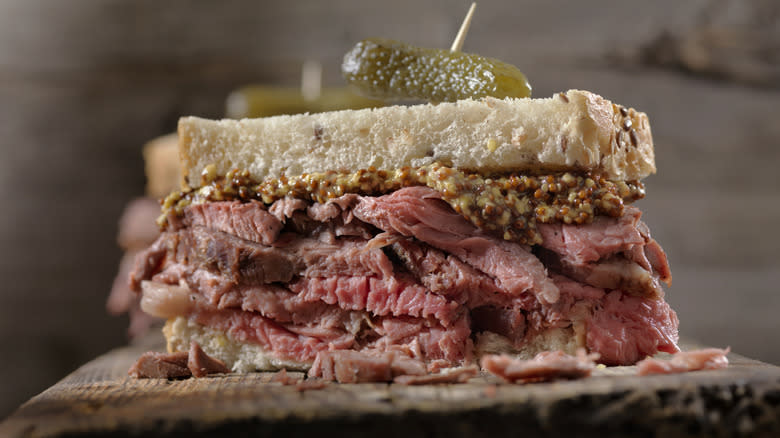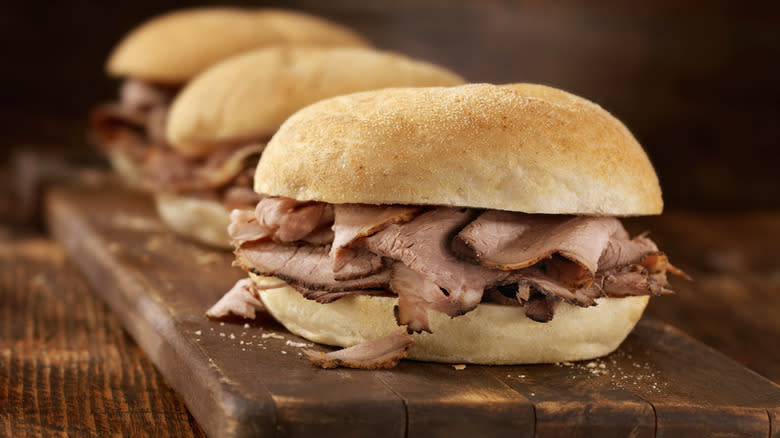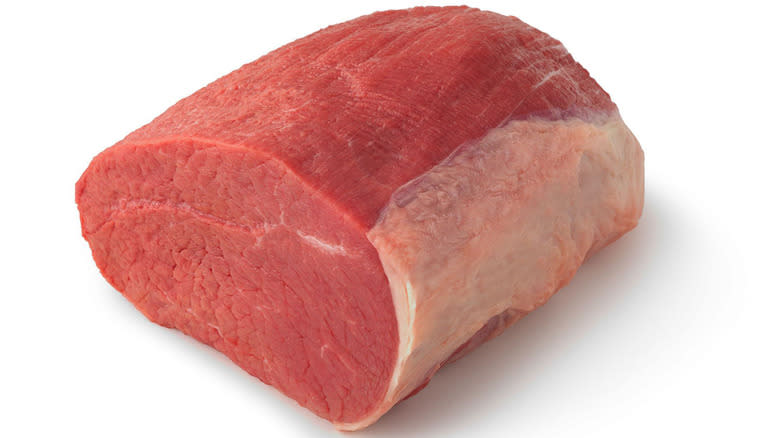The Best Cut Of Beef To Use For A Mouthwatering Sandwich

When we talk about great sandwiches, roast beef tends to get the short shrift. Part of this is because there isn't one true version of what the ideal roast beef sandwich actually is -- you only have to compare Chicago's Italian beef or French dip to the type of fare you'd order at Arby's to recognize that. But in a way, this lack of an ideal means you can get pretty creative if you decide you'd like to make a roast beef sandwich at home. And while you could just buy a package of deli meat, your sandwich will be infinitely better if you decide to roast some beef yourself.
But if you go that route, which cuts of beef should you choose? There are various schools of thought here, but the surprising answer is that the best choice doesn't actually correlate with a higher USDA grade. While top loin is a good cut to go with due to its taste and how easy it is to trim away the fat after your roast is ready, it's also pretty pricey. So instead, you'll want to look at two cheaper and leaner cuts that are often overlooked: eye of round and top round.
Read more: The Unexpected Meat You Need To Avoid Grilling At All Costs
Fattier Cuts Paradoxically Wind Up Tougher

Fattier cuts like ribeye, New York strip, or T-bone are generally regarded as higher quality meats, and they indeed make for fantastic steaks -- but that doesn't mean they're particularly good choices for roast beef. When you roast a fattier cut of beef, the fat starts to break down, basting the meat and softening the connective tissue. If you're serving your roast hot, this is exactly what you want -- so if you're serving a roast beef sandwich straight out of the oven, by all means, go for the high-fat stuff.
But this doesn't work nearly as well with cold roast beef, which is likely what you're aiming for. The issue is that as the meat cools, the fat congeals and the connective tissue hardens back up. Paradoxically, fattier cuts will wind up far tougher than leaner ones, leaving behind a gristle-laden texture that most people would not consider particularly pleasant. By contrast, tougher, cheaper cuts take very well to the slow cooking necessary for a roast. Gentle heat softens them and leaves them with a more silky texture, and they don't wind up with pockets of hard fat or connective tissue because they don't have them to begin with.
Cheaper Cuts Serve Really Well Here

Top loin might be the easiest cut to handle here, because while it's a tender cut of steak, all its fat is located on the side, meaning you can trim it off easily. But while it's great, it's also a little more expensive than top round or eye of round, so if you want to save money, those are your best bets.
Eye of round and top round tend to be an overlooked cut because they're cheaper, leaner, and tougher, leading a lot of people to conclude they're universally not as good as a fattier cut. This misses the point, though: something like eye of round is excellent as long as you know how to use it. You don't want to cook it like a steak, but there are plenty of ways to cook it that do work out great, such as steak Milanesa -- or roast beef. The same applies to top round.
With a good roast beef, you're going to be cooking it slow, and the leaner cuts clearly shine here, as the hours of cooking time give them a chance to soften without having to deal with the backlash from cooling. So feel free not to worry about breaking the bank if you want to make roast beef at home; go for the cheap cuts and be assured they'll taste better anyway.
Read the original article on Daily Meal.

